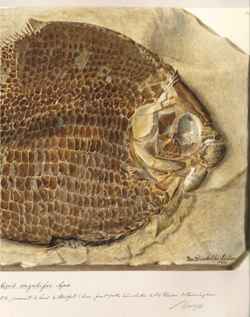
Image: Tetragonolepsis angulifer Agassiz. Watercolour by Joseph Dinkel, 1834. Taken from Richard Weaver’s Museum of Natural History, Birmingham. The fossil was reported as being found by John Greaves in his stone quarry in Wilmerts, near Stratford upon Avon, c.1830: ‘Upon splitting the stone which was 19 inches long, 11 inches broad, and about four inches thick, almost the whole of the fish was attached to one side of it...upon the other side of the stone is an exact impression, with the fins and a few of the scales only attached; the colour of the fossil is dark brown, and glossy; the scales are very perfect, and but slightly attached to the body.’ (Magazine of Natural History, vol 5, 1832).
The Library launches a project to conserve and digitise one of the most important collections housed the Geological Society’s Archive, write Caroline Lam and Michael McKimm.
Geoscientist 21.07 August 2011
The fossil fish portfolio of Louis Agassiz (1807-1873), comprising nearly 2,000 watercolours and drawings dating from the 1830s-1860s, were copied from private and public collections around Europe, principally by the German artist Joseph Dinkel.
Born in Môtier, Switzerland, Agassiz studied medicine at the Universities of Zurich, Heidelberg and Munich, during which he developed an interest in zoology, particularly of European freshwater fishes. His research for a natural history of European freshwater fishes, comparing the fossil forms from Oeningen and Glarus (Switzerland) and Solnhofen (Bavaria) sparked a life-long fascination with fossil ichthyology.
Finding the existing classification scheme inadequate, Agassiz developed his own (now superseded) scheme based on the scales and dermal appendages. The five volume Recherches sur les Poissons Fossiles, lavishly illustrated with 400 lithographic plates of fish, was issued from 1833-1843 and gained Agassiz international recognition as the leading figure in fossil ichthyology. In 1836 the Society awarded him its Wollaston Medal.